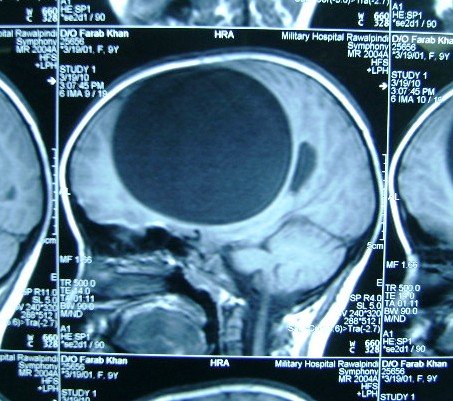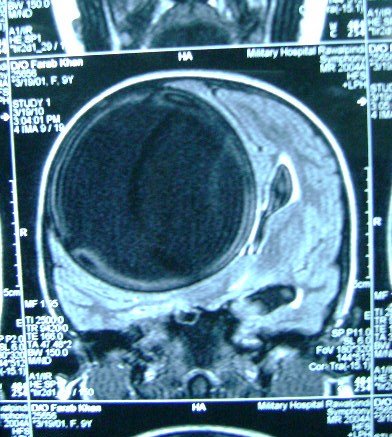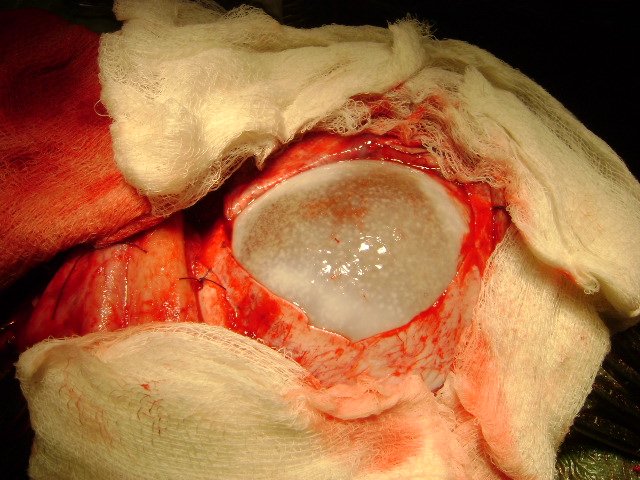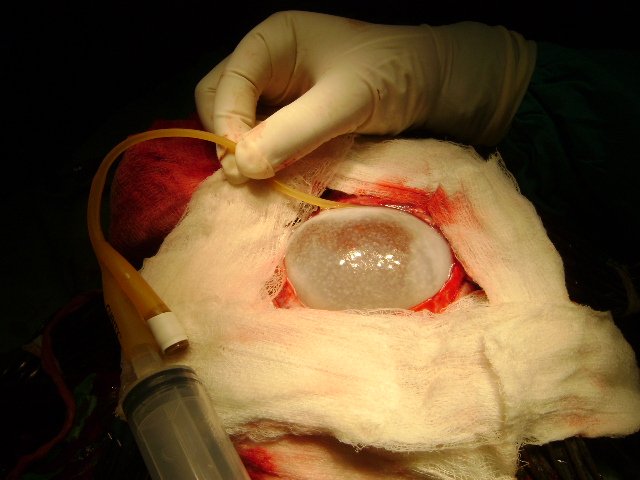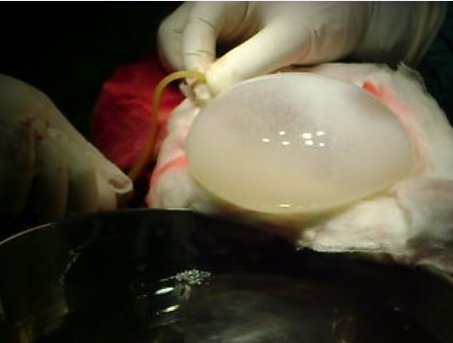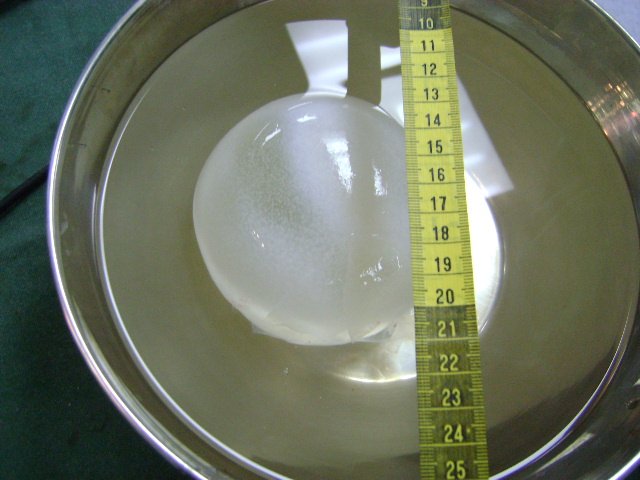Miraj Us Siraj, FRCS (Glasgow)*, Mansoor Ul Haq, FCPS**, Muhammad Imran, FCPS***
* Associate Professor and Head, Department of Neurosurgery
** Assistant Professor of Anesthesiology
*** Foundation University Medical College & Fauji Foundation Hospital, Rawalpindi (Pakistan)
Correspondence: Dr. Miraj Us Siraj, FRCS (Glasgow), Associate Professor and Head, Department of Neurosurgery,
FUMC & Fauji Foundation Hospital Jhelum Road, Rawalpindi (Pakistan); Cell: 0333 5190574, Office: 5788154-60 extension 446/321; Email – musiraj@hotmail.com.
ABSTRACT
Hydatid disease is caused by infestation of larvae of Taenia echinococcus (TE). The definite hosts of TE are various carnivores (meat eaters), and dog is the most common host. Sheep, cattle, goats and swine are common intermediate hosts. Humans are infected through faeco-oral route by the ingestion of food and milk, contaminated by dog faeces containing the ova of parasite or direct contact with dogs. Eggs lose their envelop in stomach and embryos are released, which then pass through the gut wall into the portal system and are carried to the liver where most of the larvae are entrapped and encysted. Some may reach the lungs and very rarely some may pass through the capillary filter of liver and lungs and enter into systemic circulation and reach intracranial cavity. We report a case of giant intracranial, right sided, extra axial hydatid cyst (HC) extending from right frontal region to occipital region which was removed in one piece without rupture by a procedure called hydro-dissection.
Keywords: Hydatid cyst; Intracranial; Excision in toto; Dowling’s technique; Hydrodissection
INTRODUCTION
Hydatid disease is caused by the infestation of larvae of TE. The definitive hosts of TE are various carnivores, the common being the dog. All mammals (most common are sheep and cattle) are intermediate hosts. Humans get infected through the faeco-oral route by ingestion of food or milk contaminated by dog feces containing ova of the parasite or by direct contact with dogs. The eggs lose their enveloping layer in the stomach, releasing the embryos. The embryos pass through the wall of the gut into the portal system and are carried to the liver where most of the larvae get entrapped and encysted. A case report about successful removal of a giant HC from the cranial cavity is presented.
CASE REPORT
An 11 years old girl was referred to our hospital from Khyber Pakhtoonkhwa province with 2 years history of generalized intermittent headache and progressive gait ataxia. She developed left sided weakness for 7 months and had few partial seizures before coming to hospital. On examination she was in a good general state of health, fully conscious and oriented in time, space and person. Fundoscopic examination revealed moderate degree of papilloedema. She had left sided weakness with power 4/5 in left upper and lower limbs. Reflexes on both sides were exaggerated with extensor planter response. Sensory system was intact. Systemic examination including abdomen and chest was unremarkable. Chest X ray was normal. MRI scan of the skull with and without contrast was performed which showed well defined very large sized extra axial cystic non enhancing lesion extending from right frontal region to right occipital region (Figure 1,2).
Figure 1: Sagittal MRI scan
Figure 2: Coronal MRI
The lesion caused surrounding oedema, midline shift and a mass effect. Radiological diagnosis of arachnoid cyst was made and she was scheduled for craniotomy and cyst excision.
In the operating room, she was placed in supine position and routine monitoring was started. General anesthesia was induced and intubation done securing airway. Inj. Dexamethasone 8mg was fiven IV. Other precautions for spillage from the cyst if it turns out to be hydrated, including hypertonic saline and formalin were kept stand by for combating allergic reactions to PAIR, which is a minimally invasive procedure involving three steps: puncture and needle aspiration of the cyst, injection of a scolicidal solution for 20-30 min, and cyst-re-aspiration and final irrigation. Central line and two wide bore cannulas were passed to enable us rapid infusions of IV solutions and drugs. Hyperventilation was adopted to keep EtCO2 below 30 mmHg.
Under general anaesthesia, right temporoparietal craniotomy was performed with question mark incision. Scalp flap was reflected and bone flap removed. Dura was quite vascular which was carefully cut and dural flap lifted. Under the dura, a glistening, yellowish coloured, very thin cyst wall was seen through which scolesces were also seen (Figure 3). It was confirmed clinically that the lesion was HC and not an arachnoid cyst. The manipulation of the thin walled cyst was risky because of fear of rupture. The method of Dowling’s technique of hydro-dissection was adopted to remove the cyst. As in Figure 4, a Foley’s catheter was gently introduced between the plane of dura and cyst, and with the help of a large bore syringe normal saline was slowly pushed into the catheter.
Figure 3: Cyst after reflection of Dural flap
Figure 4: Hydro-dissection
The cyst started to pop out through the dural opening (Figure 5). The catheter was gradually advanced into the same plane which was continuously irrigated with normal saline without using any blunt or sharp instrument for dissection. After approximately 25 minutes of careful hydro-dissection an intact HC came out in toto and literally fell out of the cavity like a balloon (Figure 6).
Figure 5: Cyst removal in progress
Figure 6: Cyst removed in toto
Total operating time was approximately 3 hours and 30 minutes. Patient made uneventful recovery from the surgery and was kept in ICU for few days. She developed small CSF collection underneath the skin flap which was aseptically aspirated twice and pressure bandage applied. She had had complete recovery
Perioperative corticosteroids were used which were tapered off and stopped on Day 8 post operatively. She was placed on albendazole regimen (10 mg/kg twice daily for 3 months).
Hydro dissection minimized the dangers of cyst rupture and soiling, which made the procedure very safe.
DISCUSSION
Hydatid disease is endemic in middle east, Mediterranean countries, south America, north Africa and Australia. Giant intracranial HC is very rare, with reported incidence of 1-2% of all cases with hydatid cyst. Cerebral HC is more common in paediatric population, probably related to a patent ductus arteriousus(1-4).
There was no specific history of direct contact with dog in our patient. Intracranial HC are frequently located in parietal lobe, in supratentorial compartment.(5,6) Other less common sites are skull, cavernous sinus(7), eye ball (8), Pons(9), skull(10), extra dural(11), cerebellum and ventricles(12). Intracranial HC are slow growing and become symptomatic when very large. The growth rate of HC has been reported between 1-5cm per year to 10 cm.(13)
Solitary intracranial HC’s are common than multiple intracranial cysts.(14) Intracranial HC may also be classified as primary or secondary. Primary cysts are formed as a result of direct infestation of brain without evidence of involvement of other organs. Primary cysts are fertile as they contain scolices and brood capsules. Rupture of primary cyst usually results in recurrence. The secondary cyst results from traumatic, spontaneous or per operative rupture of a primary cyst and does not have brood capsules or scolices. Secondary intracranial cysts are infertile and risk of recurrence after their rupture is minor.
The patient with a solitary giant intracranial HC usually presents with progressive focal neurological deficit and features of raised intracranial pressure(1). Presentation is usually sub acute. A minority of patients may also have seizures. CT and MRI reveal distinctive features of solitary HC. Very large rounded cystic lesion which is isodense and isointense respectively to CSF with no rim enhancement should raise the suspicion of HC. MR spectroscopy and MR diffusion weighted imaging might help in diagnosis of intracranial HC(15-17).
A variety of surgical techniques is used for removal of the HC’s (18). One option is direct puncture and aspiration of the cyst fluid through a small hole in the cyst wall, and expulsion of the cyst through a small cortical incision over cyst. The popular technique is Dowling’s technique of hydrodissection in which normal saline irrigation is used with mild force between the cyst wall and brain interface in order to deliver the cyst intact(19). This is often possible because the adhesions around the cyst wall are minimal. We performed this procedure in our case with success (Figures 4-6). It is impossible to reach a cerebral HC without opening some neural structures if the cyst is not immediately below the dura. The surgical approach to the HC may require cortical incisions, and the brain may be retracted to expose an external wall of the cyst. The incision and retraction of the cerebral cortex to reach the cyst wall may produce variable results; in some cases there has been no deficit, and in others the deficit has been transient or permenant. Sometimes the cortex and cyst wall were not clearly separated. At this point, a cottonoid is placed on the cyst wall to provide protection and to maintain the identification of this cleavage plane during cyst removal.(20)
Accidental or intentional rupture of the cyst may result in spill over of the contained fluid and scoleses. This complication may result in severe anaphylaxis, and soiling of the neighbouring tissues with potentially infective scolex heads; hence, it is to be avoided. Hypertonic saline and formalin have been injected in the cyst in an effort to control this risk, but with variable success. Vigilance is the price of safety. This quotation was never more true other than at the time of manipulation of a HC.
Albendazole is a broad spectrum oral antihelminthic drug, which acts by blocking the glucose uptake of the larvae and the adult worm. The glycogen storage is depleted, thereby decreasing the ATP formation that results in the death of the parasite.
Long-term follow-up confirms that intracranial HC’s should always be surgically removed without rupture as the outcome remains excellent in these cases. Correct preoperative diagnosis is vital for the successful outcome of surgery. A high index of suspicion is therefore required in endemic areas despite the availability of advanced neuro-imaging. Medical treatment with albendazole seems is beneficial both pre- and post-operatively.
REFERENCES
1: Erashin Y, Mutluer S, Guzelbag E : Intracranial hydatid cyst in children. Neurosurgery 1993; 33: 219-224.
2: Dharkar SR : Hydatid disease : Textbook of neurosurgery, second edition. Eds. Ramamurthi B, Tandon PN. Churchill Livingstone, New Dehli 1996; 535-544)
3. Lunardi P, Missori P, Di-Lorenzo N et al : cerebral hydatidosis in childhood : a retrospective survey with emphasis on long term follow up. Neurosurgery 1991; 29: 515-518)
4. Onal C, Orhan B, Metis O et al :three unusual cases of intracranial Hydatid cysts in paediatric age group. paediatric neurosurgery 1997; 26: 208-213)
5. Dharker SR, Dharker RS, Vaishya ND et al : Cerebral hydatid cysts in central India. Surg Neurol 1977; 8 : 31-34.
6. Balasubramanium V, Ramanujam PB, Ramamurthi B et al : Hydatid disease of the nervous system. Neurol India 1970; 18 : 92-95.
7. (Rivierez M, El-Azhari A, El-Tantaoui M et al : Hydatid cyst of cavernous sinus (a case). Neurochirurgie 1992; 38(1): 46-49.)
8. Sinav S, Demirci A, Sinav B et al : A primary intraocular hydatid cyst. Acta Ophthalmol 1991; 69 : 802-804.
9. Abbassioun K, Amirjamshidi A, Moinipoor MT : Hydatid cyst of the pons. Surg Neurol 1986; 26 : 297-300.)
10. Balasubramanium V, Ramanujam PB, Ramamurthi B et al : Hydatid disease of the nervous system. Neurol India 1970; 18 : 92-95.
11. Mathuriya SN, Khosla VK, Kak VK et al : Multiple intracranial hydatid cysts – a case report. Neurol India 1987; 35 : 163-168
12. Jimenez-Mejias ME, Castillo-Ojeda E, Cuello-Contreras JA et al : Cerebral hydatidosis. Analysis of a series of 23 cases. Med Clin (barc)M 1991; 97 : 125-132.
13. Seirra J, Oviedo J, Berthier M et al : Growth rate of secondary hydatid cysts of the brain. J Neurosurg 1985; 62 : 781-782.
14. Lunardi P, Missori P, Di-Lorenzo N et al : Cerebral hydatidosis in childhood : a retrospective survey with emphasis on long term follow up. Neurosurgery 1991; 29 : 515-518.
15. Coates R, Von Sinner W, Rahm B. MR imaging of an intracranial hydatid cyst. AJNR 1990;11:1249-50
16. Karak PK, Mittal M, Bhatia S, Mukhopadhyay S, Berry M. Isolated cerebral hydatid cyst with pathognomonic CT sign. Neuroradiology 1992;34:9-10.
17. Ciurea AV, Fountas KN, Coman TC, Machinis TG, Kapsalaki EZ, Fezoulidis NI, et al . Long-term surgical outcome in patients with intracranial hydatid cyst. Acta Neurochir (Wien) 2006;148:421-6.
18. Arana Iniquez R. Echinococcus. Infection of the Nervous System. In : Hand Book of Clinical Neurology, Part 3, Vinken PJ, Bruyn GW, editors. Elsevier/North Holland Biomedical Press: Amsterdam; 1978. p. 175-208.
19.Carrea R, Dowling E Jr, Guevera A: Surgical treatment of hydatid cysts of the central nervous system in the pediatric age (Dowling’s technique). Childs Brain 1:4–21, 1975
20. Cerebral hydatid cysts: technique and pitfalls of surgical management Yusuf Izci, Yusuf Tüzün, Halil Ibrahim Seçe,Engin Gönül, Neurosurg Focus 24 (6):E15, 2008

